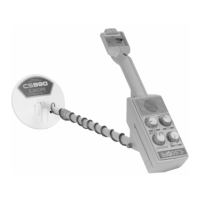CS-990 GB
5
3. Place the batteries and leads into the special recess, replace the battery cover and slide it
firmly into place until you hear it click into position.
4. Repeat this operation on the other side of the control box where the second battery
compartment is located.
Battery life will be extended if headphones are used. The headphone socket is located on the left-
hand side of the control box, on its underside. In the event that the detector is not being used for a
long period of time (over 2 months) or stored, it is strongly recommended that the batteries should
be removed from the detector, thus avoiding possible leakage and expensive repairs.
CONTROLS AND WHAT THEY DO
A. ON/OFF TUNE CONTROL
This control turns the detector on and off and sets the tuning level. It must be used in conjunction
with the Auto-Tune Button E.
To tune the detector to the optimum level, press and hold the Auto-Tune button, then switch on the
detector and turn the tune button in a clockwise direction until a faint sound can be heard and the
meter needle is in the TUNE section of the signal meter. Only then should the Auto-Tune button be
released. Any tune setting above or below this optimum level will reduce the sensitivity of the
detector. When using the detector in the field it is advisable to release the Auto-Tune button only
when the search head has been lowered to its operational or search height - i.e. ½" - 1" (1 to 3 cm)
above ground level.
B. SIMDISC CONTROL
This control enables the user to select the mode of operation desired :
- OFF - In this position the detector will give a positive signal to all metals, both via the
sound and meter channel, providing that the ground exclude switch is in the G 1 setting.
- METER - In this position the detector will ground exclude via the sound channel, whilst
simultaneously rejecting iron and small pieces of silver paper via the meter channel.
- METER & AUDIO - In this position the detector will still ground exclude, but also
identify the nature of the find in the following manner:
a) A negative signal against iron on the signal meter, and a possible unchanged needle
position for small pieces of silver paper.
b) An increase in sound level, however the frequency will decrease for iron, and an
increase in sound level with a possible slight frequency change for small pieces of
silver paper.

